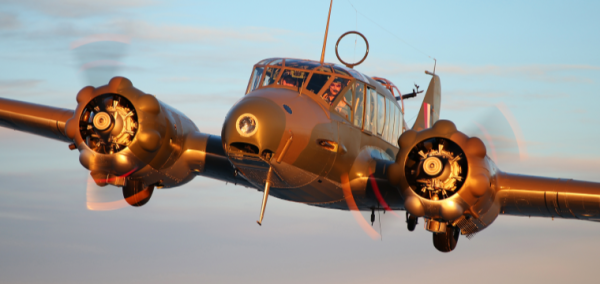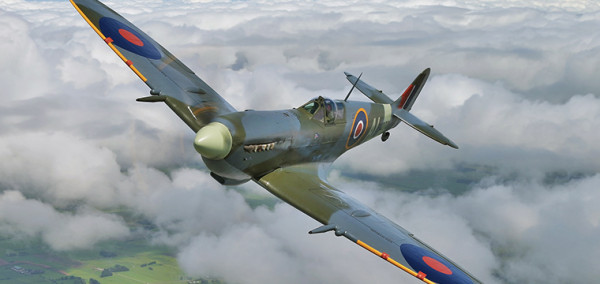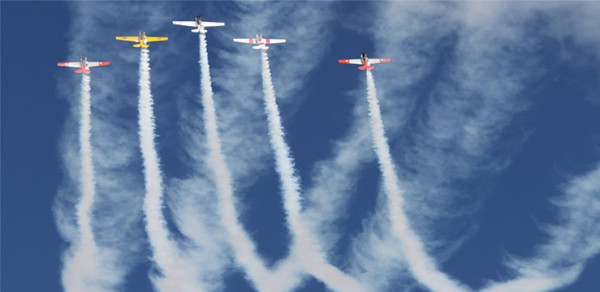After a COVID-induced hiatus, the Classic Fighters airshow is back at Omaka this Easter.
We have a new Vector Online section, so in future you won't find these articles in the New and media releases section. You might want to bookmark Vector Online.

During airshow activities in the Easter weekend, Omaka’s airspace is restricted.
This will be published in the AIP Supplement 23/3, effective 23 March 2023. Check aip.net.nz(external link) closer to the event.
By arriving in good time, you may beat the congestion!
To get safely to and from Classic Fighters, make sure you have the latest AIP New Zealand Volume 4 and the visual navigation charts covering your proposed and alternative routes.
On the day of your flight, obtain weather information and NOTAMs from ifis.airways.co.nz(external link).
Omaka aerodrome will be partially closed during the practice days of Thursday 6 April and Friday 7 April – see the AIP Supplement for times.
Also on Friday 7 April, the aerodrome will be closed for an evening airshow from 1600 to 1900 NZST.
On the main airshow days, Saturday 8 April and Sunday 9 April, the aerodrome be closed to all aircraft – 0930 until 1630 NZST.
Additionally, runways 01/19 and 07/25 will be closed between 1 April and 12 April 2023 for airshow set-up and then pack-up. Fencing, grandstands and so on, will be erected on the airfield during this period so only runways 12/30 are available.
Classic Fighters safety manager Aaron Marshall says after studying the charts, you’ll realise that Omaka has non-standard circuit directions. This is due to the proximity of Woodbourne (2.3 NM) and high terrain on final approach to 30.
“Make sure you understand the altitude constraints relating to airspace, and also the published procedures. Know the visual reporting points, and plan on possibly holding visually (orbiting) for up to 30 minutes,” says Aaron.
“Add 30 minutes extra fuel for holding time, additional to enroute fuel and reserves determined by the PIC. If high traffic volumes occur, you will be holding.
“Learn where the instrument sector is, and how the transit lanes are laid out.
“There’s one major landmark, New Renwick Road, which is the main arterial road running east to west, just 1.3 NM north of Omaka aerodrome. Don’t cross it to the north as it’s the instrument sector boundary.
“For those who have flown into the airshow before, there are some major changes in the ground layout this year. The main display line has been realigned with runway 12/30, which has resulted in the closing of both 01/19 and 07/25,” Aaron says.
Woodbourne and Omaka are situated in a unique microclimate. The surrounding hills and ranges on either side of the Wairau Valley provide orographic protection from the weather, and channel the surface wind as westerlies and easterlies. The prevailing wind direction is west or north-west. The surface wind, however, can be completely different at the two aerodromes. For example, a westerly wind can be reported at Woodbourne, but an easterly can be occurring at Omaka from the sea breeze.
In the valley system there can be considerable differences between upper-level winds and surface winds. For example, southerly airflows in Cook Strait tend to become light to moderate easterly conditions at Woodbourne and Omaka.

Be aware of the transit lane boundaries. Transit lanes are Class G airspace so there’s no reason to call Woodbourne Tower – this congests the frequency, creating unnecessary work.
“When doing an overhead join at 1500 feet into Omaka, that’s right on the boundary of the transit lane,” says Aaron.
When Omaka’s airspace restrictions are active during airshow days, the portion of VFR transit lane NZT654 sitting inside that restricted airspace becomes disestablished.
“Also remember that active portions of the transit lane finish at the end of daylight hours,” says Aaron. “During daylight hours, you should be listening on the Woodbourne Tower frequency when occupying the transit lane. The same goes for after evening civil twilight. Many pilots listen out on 119.1 MHz, in error.”
It’s recommended you track to Seddon and go through the Taylor Pass, remaining below 3500 ft and descending to 1500 ft by the Taylor Dam, at which point you’ll enter T654.
Position reports to be made entering the Taylor Pass and again at the Taylor Dam to “Omaka Traffic” on 122.80 MHz. It is strongly recommended to join via an overhead join at 1500 ft.
If strong southerlies or south-easterly winds are forecast, then avoid Taylor Pass. Instead track to White Bluffs and enter T654 at 1500 ft, and track a mile to the south of the ponds and join overhead from the Watertank at 1500 ft.
Call Omaka Traffic, entering the transit lane at White Bluffs, and again abeam The Ponds with your joining intentions. It’s strongly recommended to join via an overhead join at 1500 ft.
Be aware when tracking from The Ponds to the Watertank, you must remain over the Wither Hills and not stray over the flat industrial areas at Riverlands.
If, due to turbulence, you’re uncomfortable with remaining over the hills, call Woodbourne Tower on 122.80 MHz and request a clearance to track over Blenheim township to Omaka.
You’ll require an ATC clearance to enter the Woodbourne control zone to track to Omaka. Call Woodbourne Tower for clearance at Okaramio, if coming down the Havelock Valley, or when overhead Picton airfield if coming down the Picton Valley.
Acquire the Woodbourne ATIS on 126.05 MHz before requesting clearance on 122.80 MHz and it’s strongly recommended you join via an overhead join at 1500 ft.
Descend to 2500 ft or below and call Woodbourne Tower on 122.80 MHz at Wairau Valley township and request a Rivers arrival. Acquire the Woodbourne ATIS on 126.05 MHz prior to requesting clearance.
Ensure you descend to 1500 ft or below by The Diversion to track Omaka, remaining seaward of the coast to Wairau Bar and The Ponds to track via the Watertank to join overhead Omaka.
Make position reports to Omaka Traffic on 122.80 MHz at The Diversion, abeam The Ponds and overhead the Watertank.
Be aware, as with approaching from the south, that when tracking from The Ponds to the Watertank, you must remain over the hills, and not stray over the flat industrial areas at Riverlands. If, due to turbulence, you’re uncomfortable with remaining over the hills, call Woodbourne Tower on 122.80 MHz and request a clearance to track over Blenheim township to Omaka.

Due to the mix of high and low performance, and NORDO aircraft, a standard overhead join is preferred. This will allow you to verify which runway is currently in use and give time to locate all traffic currently in the circuit.
It also gives others in the circuit ample time to identify you and, if necessary, adjust their circuits to allow spacing. We can have aircraft downwind travelling at anywhere from 70 knots to more than 150 knots, so careful co-ordination between pilots is crucial to keeping safe.
If you find yourself confused about Omaka’s circuit directions, just remember all circuits are designed to keep aircraft away from the town. This results in all circuits being to the south of the airfield.
Have the circuit direction worked out before getting to Omaka.
Congested airfields need alert pilots, so as you approach the airfield, listen to the radio broadcasts and work out which way the wind is blowing and the vector you’ll be landing on. A warning about vector 30 – if you’re high on your approach profile and fast (due to terrain), go around and circuit the correct direction (left).
Don’t land long and become a newspaper story.
An RD Petroleum fuel truck will be available Friday, Saturday, and Sunday. Any aircraft wanting to depart on Monday should refuel from the truck before Monday, because there will be limited fuel available, and access to the fuel pumps can become quite congested. If you don’t have an RD account, they can accept BP fuel cards, but you have to make arrangements for this before requiring fuel.
There are also two maintenance facilities available on the airfield, Sounds Aero Maintenance and JEM aviation. They’re willing to help, but please be aware that many working there are also volunteers at the airshow, so may not be able to tend to your defects immediately.
All general aviation aircraft need to be parked in the eastern-most parking area, south-east of the Omaka Aviation Heritage Centre.
From Thursday, marshalls on quad bikes with ‘follow me’ signs will help direct aircraft. Taxi slowly and follow command signals. If unsure about any marshalling command, stop.
Please remember there’s limited parking at Omaka over the airshow period, so if all parking spots are taken, be prepared to fly to Woodbourne and park there.
Flying into an airshow has become a big part of many pilots’ airshow experience, and many find the journey is as much an experience as the event itself.
Venues such as Omaka do have limitations, however, requiring pilots to be extra vigilant. A bit of preparation will ensure we all have a good experience and make it home safely.